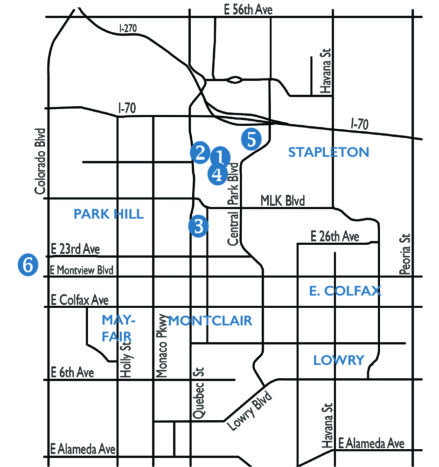 1) Still No News When the Horns Will End,
1) Still No News When the Horns Will End,
But we understand more about what’s causing the delay
In a world where driverless cars are said to be just around the corner and artificial intelligence is about to replace many of our jobs, why haven’t the engineers been able to make the crossing gates consistently go up and down with the proper timing? After more than two and a half years of train horns, the bottom line still is this—there will be no quiet zones until the gates operate “as designed” with constant warning times.
With a system that’s the first of its kind, the timing window (when gates go down before the train arrives and how long they stay down after the train leaves) was initially based on algorithms. In Sept. 2017, with a year and a half of real data, RTD asked for and received approval to add 20 seconds to that window, saying that longer window was more appropriate for this system.
FRA’s Bombshell Letter to RTD

This early 2016 photo of the Operations Control Center for the RTD Commuter Rail trains was taken during testing before opening to passengers.
But in mid-November 2018, the Federal Railroad Administration (FRA) sent a letter saying, “Despite FRA approving RTD’s request for additional warning time…recent FRA inspections have found that neither the WCAS (wireless system) nor the CTWS (conventional system) consistently provide warning times within the acceptable ranges allowed… For instance, during the week of August 13, 2018, FRA inspectors identified 63 instances of warning times outside the acceptable ranges…”
The letter went on to say that federal regulations require that warning devices at crossings within quiet zones must provide constant warning times and any waiver to allow a quiet zone “would need to be predicated on the existence and use of a…warning system that reliably activates as designed…FRA cannot justify granting this waiver request until RTD demonstrates compliance…”
The letter concluded with this bombshell, “If RTD fails to submit an acceptable action plan within 30 days… FRA will have no choice but to consider other actions as appropriate, potentially including enhanced enforcement, modification of the existing waiver…or revoking the waiver.” RTD Spokesperson Laurie Huff says, “Revocation of the FRA waiver is not the same as shutting down the line. RTD will do everything possible to ensure that the plan is accepted and implemented such that our service is not impacted.”
RTD Replies
On Dec. 18, RTD Commuter Rail posted their 73-page reply to satisfy the FRA’s requirements and keep the trains operating (available as a PDF with this story on our website). Near the beginning is a statement that gets at why there’s such a big focus on precise warning gate times: “Some safety experts believe that crossings are safer where warning times are as short as reasonably possible and relatively consistent so that the public does not distrust active warning devices and does not attempt to cross the tracks with a mistaken belief that the train is not really coming.” (With four gates at each intersection blocking all lanes, do motorists really crash through the gates if the time at one gate is longer than that at another?)
The data for the commuter rail shows that approximately 90% of all warning times are within the design-warning times for all crossings (with an exclusion noted). The A Line has eleven crossings, ten of them shared with Union Pacific Railroad. RTD Commuter Rail is the only railroad using the crossings that has Positive Train Control (PTC), where braking happens automatically if the train is approaching the crossing too quickly.
Predicting when a train will arrive? It’s complicated
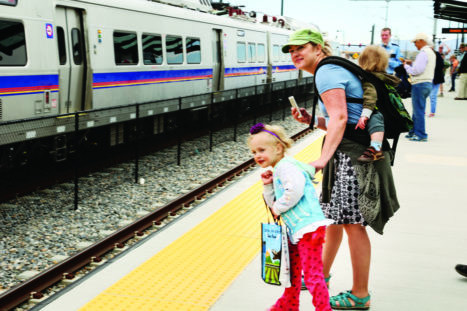
Passengers wait at Central Park Station.
RTD’s letter states, “The accuracy of the prediction is affected by known factors, such as the actual speed of the train at the point… [the signal to close the gate is activated]. Accuracy is also affected by factors not known or controllable by the system, for example an unanticipated decision by the train operator to slow down after the crossing has already been activated based on his/her judgment approaching the crossing. Human operators have the freedom and responsibility to adjust train speeds for conditions…a passenger train operator may allow more time at a station stop for passengers to board than is typically needed.”
Wireless signal interruptions—The software for the commuter rail system uses a wireless signal that adjusts gate timing based on actual train speed. If there’s an interruption in wireless connectivity, the system reverts to a simpler conventional system that will close the gates, but that system cannot adjust gate timing based on actual train speed. The report noted that new construction around Union Station has resulted in more interruptions in wireless connectivity, which has created gate-timing issues up the line. RTD Commuter Rail is working on a fix for that problem.
Longer than expected station stops —Variation in the length of time that trains stop in passenger stations (dwell time) causes variability of warning times. RTD Commuter Rail will seek a method of reducing or eliminating the impact of dwell time variation on warning times. Dwell times at the Central Park station are typically longer than the assumed 35 second dwell time and may be a factor in lengthening the warning times at Holly and Monaco. The report notes that further improvement may be possible with additional study of actual operations at Central Park Station.
Additional causes of longer warning times
- Orders for train operators to stop or slow at a crossing due to a report of a possible warning system malfunction.
- If the positive train control system applies the brakes because a train will arrive too early, the train has to stop and re-initialize in Positive Train Control (PTC) before being able to move again.
- As a result of a PTC issue (due to loss of GPS signal, for example) the train operates in the conventional rather than the wireless system.
- Weather, poor visibility and other factors may cause operators to move more slowly than predicted.
Finding Solutions
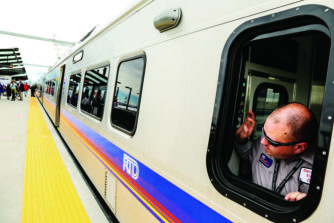
An RTD commuter rail driver looks out from the cab (shown at right) before closing train doors.
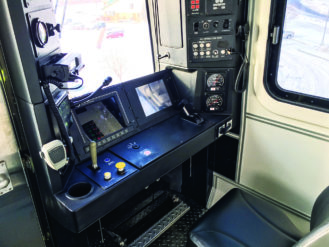
The FRA identified concerns about the Holly and Monaco crossings. When timing issues there were studied, analysts discovered that the acceleration and deceleration times of trains approaching these crossings had evolved significantly with increased operator experience. As data has become available, “Approach Condition Adjustment Factors” (ACAF) have been introduced in the algorithms that predict train arrivals and gate closure and opening. The FRA approved new ACAF values that were implemented recently for the Monaco crossing. Data shows warning times for both Monaco and Holly have improved since that was implemented.
In the 73-page document, RTD wrote detailed explanations of these types of issues and reiterated their commitment to collect and analyze data and continually make adjustments to limit the impact they have on warning times.
2) RTD Increases Seats on A Line
Laurie Huff of RTD provided this statement: “Starting in January, we are doubling capacity on the University of Colorado A Line. This means we are adding cars to each train, so what previously had been two-car trains will become four-car trains. We are making this change because of growing ridership, which is 24,000 boardings on an average weekday to date this year. The University of Colorado A Line has carried well above 16 million riders since it opened in April 2016.”
3) Forest City Has Been Sold to Brookfield Asset Management
Brookfield, the new master developer of Stapleton, will take over all of Forest City’s contractual obligations. Jim Chrisman, who was senior vice president of Forest City, points out that Brookfield acquired multiple other large projects and Forest City staff have not yet been informed of future staffing or office changes. We may learn more in late January.
4) Sprouts
David Friedman purchased the land near the Central Park Station in late May/early June 2018 to build a Sprouts, other retail and residential properties, but we have not received a response when we’ve asked about the construction schedule.
5) Construction by I-70?
What looks like a large construction project on the west side of Central Park Blvd. at I-70 is actually “prep work for bringing fill to the site,” says Jim Chrisman.
6) Denver Preschool Showcase
The seventh annual Preschool Showcase will be held at the Denver Zoo’s Norgren Hall on Saturday, Jan. 12, 2019, from 9am to 12pm. This free event enables Denver parents to meet with staff from more than 50 local preschools to help them make an informed decision about preschool next fall. Parents can also learn how to sign up for tuition support through the program. Participating families receive free admission to the zoo. For more information visit www.dpp.org/news/showcase-2019.
7) Scooter Rules Change
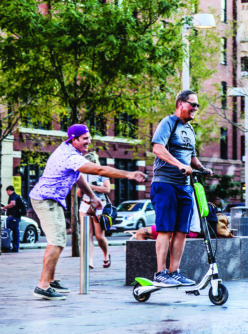
Scooter enthusiasts have embraced the new mode of transportation in downtown Denver.
City Council representatives Mary Beth Susman and Paul Kashman have introduced a new ordinance about scooters that puts scooters in bike lanes, when available. According to Susman, “It primarily gets scooters off the sidewalks unless a road speed limit is higher than 30 and there is no bike lane, but then the speed limit on a sidewalk is 6 mph.” It goes to full council Jan. 7. The proposed ordinance is linked to this article on our website at FrontPorchNE.com.
8) Rename Stapleton Contests MCA Vote
Two candidates from the recent MCA delegate election, Cora Galpern and Mandle Rousseau, who were endorsed by Rename St*pleton for All, contested the outcome of their elections. The candidates, upon review of the ballots, found that Forest City had cast their votes on a single ballot rather than filing individual ballots, and the signature on the ballot did not match the name of the owner. The lawyer from the MCA determined that the votes were, in fact, valid, and the election results stand.




0 Comments